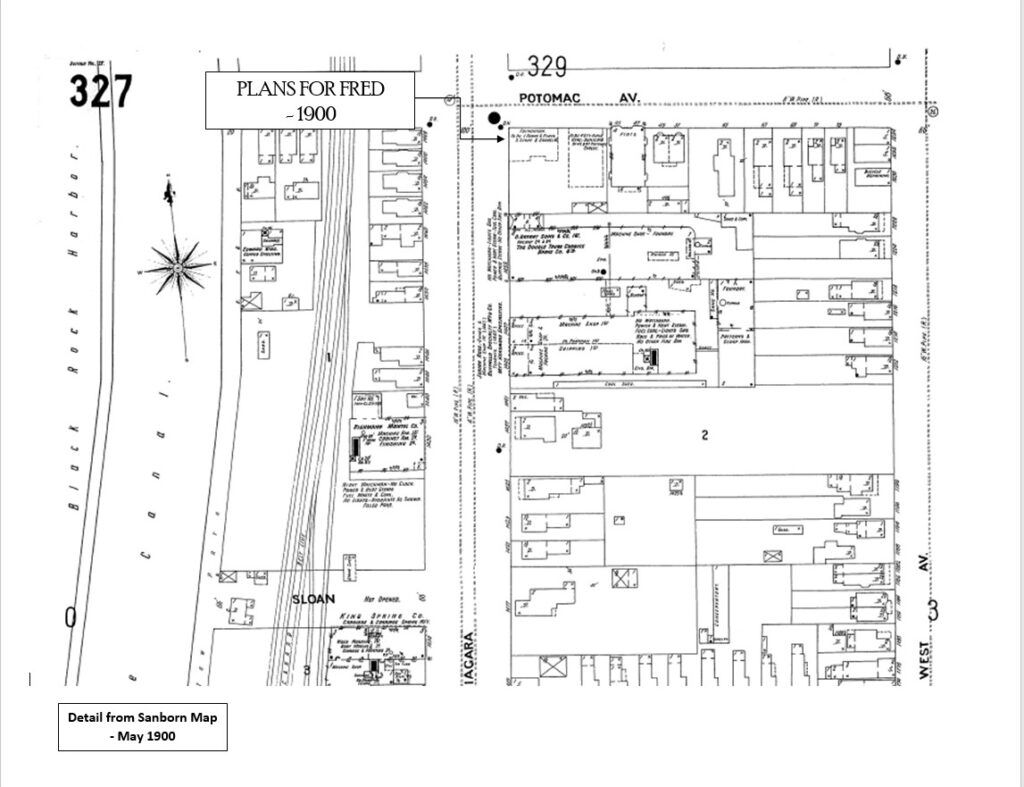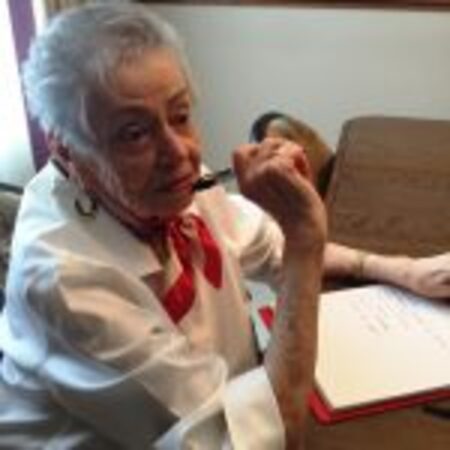Historical Research

Sanborn Map-Plans 1900
In the fall of 2012, the Orphan Building Research Team began its historical fiction project using primary and secondary resources. The team worked backwards and forward, switching between resources to track Fred’s history from 1900 through 2018. Historical books and websites were of vital importance to set a realistic framework of Buffalo, New York in the Twentieth Century.
Discovering the facts regarding the original construction of Fred’s apartment building and the changes made over eleven decades was a challenge. This six-year project began with copies of two original pictures of the apartment building in the 1940’s and 1950’s. The new pictures we took from 2006 through 2012 made us fearful that Fred may not survive subsequent damage to his structural integrity. The research further identified all the businesses that were located on the first floor of the building.
The research priority was to identify the tenants who actually lived in the building, including tracking the number of years they lived there. Our research team discovered a wealth of demographic information, including tenant ages, ethnicity, and occupations. Each fictitious character emerged from my imagination. Actual historical events inside and outside America were identified to allow this author to recreate realistic events for each character and their families. Our research consisted of a multitude of historical resources. We extend a special thank you to the Church of Latter Day Saints Family History Center and their welcoming staff for their excellent assistance and guidance.
Our appreciation further extends to the staffs of the Buffalo & Erie County Public Library and Grosvenor Library for teaching us how to find and use all of the important resources we needed. They included The Polk City Directories, Buffalo Address Books, Sanborn Fire Insurance Atlases, Ordnance Survey Maps, Children’s Aid Annual Reports, Deed and Property Records including local history files, Federal and State Census Reports, Child and Family Service Records, New York State Death Records, and local newspaper archives.
We appreciate and thank the Buffalo History Museum’s staff for the use of their directories and excellent photograph collections. Another valuable resource was the Intensive Level History and Black Rock Tax Assessment Records, located in the City of Buffalo Inactive Records Center. Their staff was extremely helpful in teaching us how to interpret Fred’s records.
The D’Youville College Archives took us back in time starting in 1908. Their records helped me to learn what it was like for young women attending college over a century ago.
Many historical books were reviewed several times, helping this author learn about Buffalo’s early history. They included three books written by Mark Goldman: The Challenge in Buffalo, New York 1990, City on the Edge, Buffalo New York 1900-2007, and High Hopes: The Rise and Decline of Buffalo, 1993. They were significant to understanding the roots of Buffalo. America’s Crossroads: Buffalo’s Canal Street/Dante Place; The Making of a City, authored by Michael N. Vogel and Paul E. Redding and edited by Edward J. Patton and Elizabeth Foy, was a valuable and constant resource regarding life in the Canal District in the 1900’s and its effect on new immigrants to America. Additional books included: Strangers in the Land of Paradise: The Creation of an African American Community, Buffalo, NY 1900-1940 written by Lillian S. Williams in 1999, Children of the Settlement Houses, written by Caroline Arnold in 1998; and Immigrant Kids, by Russell Freedman, originally published in 1980. David H. Kelly: The D’Youville College Family Album: 100 years of Teaching and Caring 2008 by D’Youville College.
Significant historical websites provided us with a wealth of information and included The Ancestry Library, The Library of Congress, Canadian Genealogy, Western New York Heritage Press, The Buffalonian, Buffalo Research, Buffalo History Index, Buffalo Architecture, and the Circle Association’s African American History of Western New York State 1900-1935.
An extended thank you to the multiple individuals we interviewed regarding their childhood memories. They were instrumental in helping characters come alive on the pages of this novel.
Sample Historical Highlights
FRED: Buffalo Building of Dreams
Historical Highlights (not in chronological order)
On July 15, 1895, the famous Niagara Starch Works Factory exploded on Howard Street in the City of Buffalo.
On February 16, 1861, Abraham Lincoln’s inaugural train stopped in Buffalo on his way to accept the Presidency of the United States.
On April 27, 1865, Abraham Lincoln’s funeral train arrived in Buffalo at 7:00 a.m. at the same Exchange Street Station.
Colera – in 1854, the year more than three thousand cases of the disease was recorded in Buffalo, New York.
The Great Strike of 1899 and stories about the Irish football match at the Pan-American Exposition in 1901.
The Hull Settlement House on the West Side of Chicago, Illinois was co-founded by Jane Addams and Ellen Gates Starr and Buffalo’s Young Suffragettes, pioneer social workers and reformers in 1899.
Famous Suffrage poster by Buffalo Artist Evelyn Rumsey, 1905 message “Give her the fruit of her hand and let her own works praise her in the gates.”
Welcome Hall Settlement House Program in Buffalo’s Canal District founded by Mary Remington, a Massachusetts social reformer.
D’Youville College, founded by the Green Nuns was the second women’s college built in New York State in 1908.
On March 3, 1913, the first suffragette March to Washington’s District of Columbia was held and organized by Alice Paul and Lucy Burns, social reformers and suffragettes.
August 7, 1913, Theodore Roosevelt’s Progressive Party became the first national party to adopt a woman’s suffrage plank under their equal suffrage statement.
May 18, 1917, the Selective Service Act and last draft on September 12, 1918.
November 11, 1918, World War I ended.
The Buffalo Children’s Aid Society founded in 1873.
Story of Kitty O’Neil, famous Irish Jig dancer/singer in the 1870’s and 1880’s.
Annie Edison Taylor story. On October 24, 1901, sixty-three year old Annie became the first person to survive a trip over Niagara Falls.
Sicily’s crop failures, high taxes, and unstable Italian government and immigrants to America in 1880.
Ireland’s terrible Potato Crop Famine, beginning in 1845.
On June 9, 1914, a successful Western New York Suffrage Parade down Main Street in the City of Buffalo.
On July 14, 1917 Janet Fortherington, a Buffalo teacher of physical culture was among the first suffragette to picket and chain themselves to Washington, D.C. monuments.
1918 – During World War I, women all over the country collected thousands of corsets for the cause. Women donated twenty-eight thousand tons of metal with enough to build two battleships.
Deaths before Buffalo’s Influenza epidemic ended on November 13, 1919.
The effects that the Immigration Act of 1924, Canadians were exempt.
Peace Bridge Construction Project 1925.
The famous Irish Brigade that served in the Union Army between 1861 and 1863.
The U.S. Stock Market crash October 1929.
The U.S. Citizenship and Immigration process.
A Polish and Russian Jew from the Pale of Russia, box car riders arrive in Buffalo on a New York Central box care at the Lackawanna Station from their deplorable settlement house east of New York City Bowery.
President Franklin D. Roosevelt’s New Deal Works Projects Administration (WPA) spring of 1935 – 1943. Eight years of existence.
The Triangle Shirtwaist Company Fire in the ASCH Building in Greenwich Village area of New York City March 25, 1911.
Santaserio’s West Side Restaurant – one of Buffalo’s oldest restaurants saved many of Fred’s generations of tenants during the Great Depression and difficult times.
Buffalo’s Civic Stadium Rock Pile built as a WPA Project in 1937.
The Orphan Train Program – 1853-1929 formed by Charles Loring Brace and a group of social reformers, who also founded the Children’s Aid Society (CAS).
The Mentholatum Company built in 1919.
The Saint Vincent DePaul Orphanage in Buffalo taught young women to become educated both spiritually and self-sufficient. 1860’s – 1930. (dates not in book)
Rowntree’s Chocolate Factory of York, England – one of the three confectionery manufacturers was owned by the Quakers founded in 1862.
Survivors of the worst air raid in World War II, York, England, Wednesday April 29, 1942 (chocolate ladies).
Fowler’s Chocolate Factory – 1901 – present. Founded by Joseph A. Fowler who traveled to Buffalo from Canada to participate in Pan American Exposition.
Army Captain George H. Maines originated the idea of the Blue Stars of America to honor all military service men and women fighting or killed in World War II.
During World War II, Military v-mail limited to one piece of paper the size of a writing tablet folded into an official envelope because they were read before soldiers received them.
Production soldiers – women of all ages hired to operate large cranes, welders, riveting dull press operators, taxi cab drivers, and volunteer firefighters during World War II.
The Bolton Act of 1943, sponsored by Frances Payne Bolton, created the U.S. Cadet Nurse Corps.
F.N. Burt Company Box Factory. The largest manufacturer of small paper boxes in the world. Built in 1901 with additions through 1926.
Vietnam War draftees. September 10, 1963, President John F. Kennedy set up Executive Order 11119 which exempted married men 19-26 from draft. Bobby Mooney drafted in 1963.
Hungarian Freedom Fighters – 1964 move into Fred – two brothers first immigrated to Buffalo in 1957 from Communist Hungry.
F.N. Burt Company Box Factory. The largest manufacturer of small paper boxes in the world. Built in 1901 with additions through 1926.
Displaced Person Act of 1948 allowed certain people displaced by Work War II to qualify for permanent residence.
Nancy Pocock, a Canadian Quaker and peace activist, opened home to those who crossed into Canada to avoid the draft and to also provide shelter to people escaping from Vietnam.
The Jones Shafroth Act. March 1917 – President Woodrow Wilson gave Puerto Ricans U.S. citizenship.
Cocina Criolla (creole cooking)
Buffalo based Pillsbury Flour Company built in 1924.
Fugitive Slave Act of 1850.
Hungarian Freedom Fighter Refugee brothers arrived in Buffalo under the Displaced Person Act of 1948 which allowed certain people displaced by World War II to qualify for permanent residence.
Lehigh Railroad was one of many railroads built in the Northeastern United States to haul anthracite coal – 1880.
Black Diamond Steamer was the flagship passenger train of the Lehigh Valley Railroad. New York to Buffalo 1896 – 1959.
Buffalo Zoological Gardens – major renovation – WPA 1930’s.
Ford Plant – in 1950, Ford opened the Buffalo Stamping Plant to manufacture certain metal parts.
General Motors Plant #1 located at 2995 River Road in Buffalo was built in 1941.
Harriet Beecher Stowe, author of Uncle Tom’s Cabin, an anti-slavery novel published in 1852.
Abolitionist Fredrick Douglass born in 1818 in Tuckahoe, Maryland wrote his autobiography of his life, The Narrative of the Life of Fredrick Douglass; An American Slave.
William Lloyd Garrison founded The Liberator, an abolitionist newspaper, published weekly from January 1, 1831 until December 29, 1865. Helped thousands of slaves escape from the south on the Underground Railroad.
1858 Abolitionist John Brown advocated the use of violence to abolish slavery.
Brookgreen Plantation in Georgetown, South Carolina owned by the King of the Rice Plantations.
Josiah Henson wrote the Life of Josiah Henson, Formerly a Slave, Now an Inhabit of Canada, narrated by Henson himself in 1849.
Harriet Tubman, an Abolitionist was called the “Moses of Her People” went into slave country 19 times by 1860.
The Calhoun, a slave ship journal memory, 1856.
January 1, 1863, the Emancipation Proclamation freed slaves in states still in rebellion.
The 54th Massachusetts Infantry made up of mostly free northern black men.
William Still Freeman I, born a free African American in 1858 in Alleghany County, Pennsylvania, in an area of norther coal mines. Conductor of the Northern Underground Railroad in 1872.
John Henry Hill, Sojourner Truth, accomplishments, Vietnam veterans, culture, traditions, and true historical facts regarding Longhorn cattle, “African Cowboys” and their agriculture, customs, traditions, culture, foods, achievements.
Sullivan Islands, South Carolina where 882 ships arrived with an estimated 260,000 Africans.
Orphan Building Research Team

Frances R. Schmidt

Patricia Smyton

Janet Mazzaroppi
Support Team

Jane Hauser

Jane Killewald

Tiny Sharon
